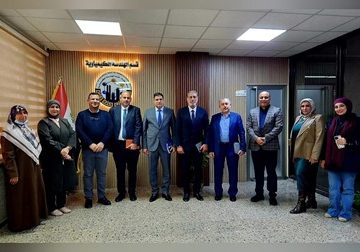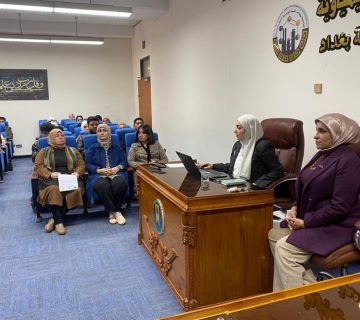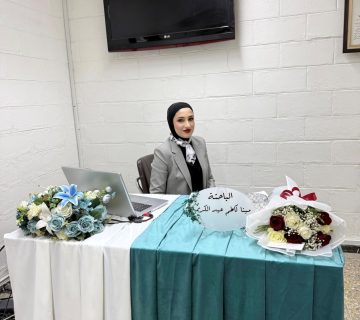The Chemical Engineering Department at the College of Engineering, University of Baghdad, held a Ph.D thesis examination titled:
“ Synthesis of Multi-Layer Membranes for Dye Removal from Water Solutions using
Cross-Flow Filtration System
“
By the student Ihal Ali Abed and supervised by Asst. Prof. Dr. Basma Ismael Waisi. The examination committee consisted of Prof. Dr. Mohammed A. Atiya as Chairman and the membership of Prof. Dr. Rafie Rushdy Mohammed, Prof. Dr. Najwa Saber Majeed, Prof. Dr. Muthanna J. Ahmed, and Assist. Prof. Dr. Tariq M. Naife. After conducting the public discussion and listening to the student’s defense, the thesis was accepted. The thesis was summarized as follows:
Industrial wastewater consists of a wide variety of organic and inorganic contaminants, which mandates the adoption of purification procedures before its discharge into the surrounding ecosystem. This entails the elimination of dyes, along with several other harmful substances.This research aimed to prepare and investigate the efficiency of ultrafiltration membranes for removing dyes. It also studied the factors affecting the performance of the membrane separation process. Malachite green (MG) dye was used as a model contaminant to investigate the dye removal efficiency. The dye concentration in the solution was measured to be (10 mg/L) under a pressure of (6 bar) by a prepared polyether sulfone polymer PES-based flat sheet membrane of (150 μm) thickness using a cross-flow filtration system. The membranes were characterized using FTIR, AFM, porosity, and SEM measurements.
The ultrafiltration membranes were prepared by solving the Poly ether sulfon (PES) polymer at (16 wt.%) at thickness (150 µm), pressure (6 bar), and temperature(35˚C) in Dimethylformamide (DMF) by the phase inversion method. The result recorded no permeate flux.
To adjust the pores structure of the prepared PES-membrane, a specific amount of polyethylene glycol polymer (PEG) was added to the precursor solution to increase the membrane porosity. The examination involved the analysis of PEG polymers with varying weight percentages (5, 10, and 15 wt%) at thickness (150µm), pressure (6 bar), and temperature(35˚C), The best concentration of PEG polymer in the ultrafiltration membrane (5 wt.%) of PEG was excellent for achieving the desired performance in ultrafiltration. The membrane exhibits a notable removal efficiency of (94%) with (50 LMH) permeate flux.
Then, the effect of membrane thickness (100, 150, and 200 µm) and coagulation bath properties, including temperature (15, 25, and 35 °C) and composition (0-30 wt.%) DMF in water on the fabricated membrane, were investigated. According to the results of flux and rejection, the best membrane thickness was (150µm), temperature (25°C), And the(20wt.%) DMF .
In order to improve the permeability and removal efficiency of the ultrafiltration membrane, the polymer membrane was improved by embedding TiO₂ nanoparticles. Titanium oxide (TiO₂) was used at concentrations of (1, 1.5, and 2 wt.%) while keeping the PES polymer concentration constant at( 16 wt.%). The addition of nanoparticles TiO₂ helped to increase the membrane porosity. Where it was discovered that in terms of permeability, the performance of composite membranes improved. The ideal TiO₂ nanoparticles concentration in the membrane ultrafiltration is 1.5 wt.%. This membrane has the best porosity,permeate flux, and a high removal efficiency.
For further improvement in the membrane efficiency (permeability and dye rejection), the best membrane was chosen at (150µm) thickness, temperature (25˚C) and pressure (6bar) to be coated by a layer of electrospun pure Polyacrylonitrile (PAN)- based nonwoven nanofiber on the top surface of the fabricated membrane producing dual-layers membrane. The nanofibers were fabricated by electrospinning technique at (25˚C). The result recorded (36 LMH) permeate flux of the dual-layer membrane and (94%) dye rejection, compared to the single-layer membrane (94.5%) dye rejection, while the permeate flux (35 LMH). The membrane was further enhanced by the addition of TiO₂ nanoparticles at (1%wt) weight percentages. The results found the dual-layer membrane with nanoparticles increased the flux and the dye rejection to (96.5%) compared to the dual-layer without nanoparticles. The multi-layer (triple layer) membrane prepared at the same conditions using the same described method on the other side of the dual-layer of the membrane becomes a multi-layer membrane.The triple-layer membrane showed the best performance over both single-layer and dual-layer TiO₂ addition and without TiO₂ addition membranes.








